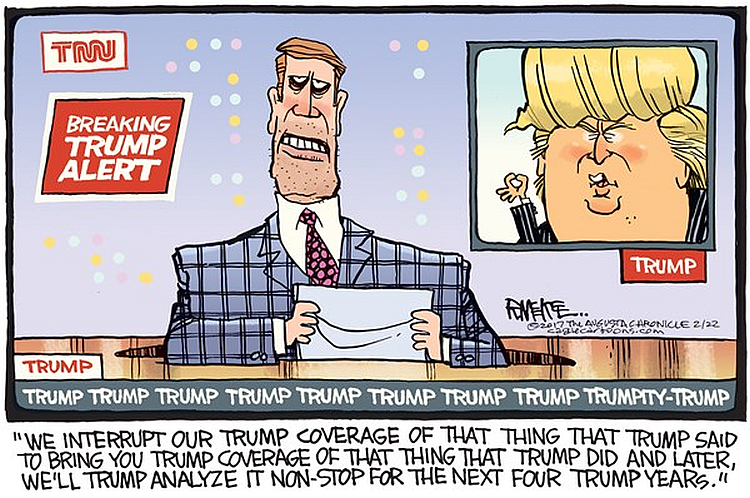On Cable News, It’s Been 2016 for Four Years Straight
Previously, for Columbia Journalism Review, I demonstrated that print media seems to be obsessed with Trump. The extent to which they cover him is without historical precedent.

In 2018, “Trump” was the fourth most-used word in the New York Times. On average, Trump was directly mentioned 2-3 times in every article, and indirectly mentioned an additional 1-2 times. Critically, this was an average that included all articles published by the Times (including weather, sports, fashion, etc.). Trump had ceased to be just a topic of news; he seems to be the prism through which we interpret and discuss reality.
Although interpreting virtually everything through this political lens has a number of negative consequences for American culture and society, the bottom line is, it has been great for business. The Times saw a record spike in subscriptions over the course of the 2016 election cycle, due largely (in the Times’ own accounting) to the mutual antagonism between Trump and the paper of record. The publication now boasts a record high number of paid subscribers consuming their Trump-laden content. They are not alone. Many outlets have seen sharp increases in readership and subscribers by capitalizing on (and reinforcing) the obsession with Trump.
A new tool from Stanford University’s Computer Graphics Lab reveals that cable news has undergone a similar transformation. The Stanford Cable TV News Analyzer allows users to, among other things, to track cable news screen time for anyone they’d like, from 2010 to present. Looking at Trump relative to Barack Obama, Hillary Clinton and Joe Biden reveals a number of striking patterns:

First, the media gives Donald Trump about twice as much airtime per day as they gave Obama from 2010 to 2016. Comparing Trump to his 2016 and (especially) 2020 rivals is also dramatic: Trump received significantly more airtime than Hillary Clinton virtually every month of the 2016 campaign, and Joe Biden is nowhere close this cycle.
During the 2016 campaign, from August 2015- November 2016, cable news aired about two hours (123 minutes) of Trump per day. And of course, this is just a fraction of the total coverage, as every clip of Trump speaking is typically bookended with (panels of) other people talking about what Trump was going to say or just said – building 10-minute segments out of 2 minutes of Trump talk.
What is most striking in the data, however, is what changed after the election – because almost nothing changed. In 2017, the average was 110 minutes per day; in 2018 it was 114 minutes; in 2019, 112 minutes — and so far in 2020, 110 minutes. That is, there is a mere 10 minutes per day difference (collectively!) between the levels of airtime provided for Trump during his groundbreaking campaign, and the amount of airtime they’ve given to him every day since. If people are exhausted, it’s no surprise: news media has basically been running on 2016 campaign intensity for four years straight now.
This becomes even clearer when we break out Trump airtime by network. The coverage is extremely steady from 2015 through the present; fluctuations notwithstanding, the overall trend in the data is basically flat:

Perhaps more surprising is how the trends in coverage break down. A lot of attention has been paid to the relationship between Fox News and Trump. Although Trump does get a bit more airtime on Fox than CNN, the difference is actually not that great. In fact, the network that consistently gives Trump the most airtime is not Fox News, but MSNBC. The channel’s views may hate Trump, but they keep serving them Trump content. It doesn’t matter that viewers are watching to feed their outrage; all that seems to matter is that people are watching.
Trump professes to hate the media. Meanwhile, journalists and media executives profess to hate Trump. Yet they are also obsessed with one-another. And Americans can’t seem to look away: like print media, cable news outlets have enjoyed record ratings and huge increases in ad revenue by fetishizing the president.
There is wall-to-wall and breathless coverage over every outrageous word and action – often leading outlets to inadvertently report incorrect information in their bid to keep everyone glued to their seats. They fact-check Trump constantly. But of course, they do this only after airing, and then often repeating, misinformation. This can create what psychologists call an ‘illusory truth effect,’ where people end up remembering the falsehood, forgetting the correction – and then attributing their misinformation to the very source that had tried to correct it!
In short, the media, the president, and the public seem to be locked into the world’s worst relationship triangle. And as we hurtle toward the 2020 election, we could be headed for an even more terrible breakup.
Update: 4/30/21
As anticipated, 100 days into Biden’s term in office, Neilson reports that television news media viewership has plummeted, and indeed, MSNBC, CNN and Fox have seen steep declines across platforms. They are far from alone. Traffic on news media websites across the board have seen steep declines since Biden’s inauguration. Having built their coverage almost entirely around Trump for the last four years, they now find themselves at a loss.
